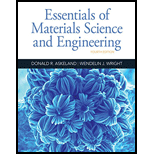
(a)
Interpretation:
The amount composition & hardness of material at
Concept Introduction:
Microstructure is a very small structure of any material. For a material, it describes the physical properties like hardness, strength, ductility, temperature behaviour and corrosion resistance of the material. The properties of any substance can be observed under optical microstructure. Materials such as metals, polymers, ceramics or composites show optimistic properties under microstructure.
Answer to Problem 12.103P
The composition, hardness and amount are
Explanation of Solution
Given:
Graph showing
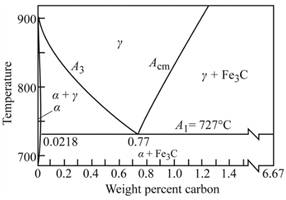
Calculation:
As shown in the given diagram, at the line
As from the figure, the effect of hardness of martensite in steel, the hardness of martensite at
Where, %M=amount of martensite
Put, the values in lever rule,
Therefore,
(b)
Interpretation:
The amount composition & hardness of material at
Concept Introduction:
Material hardness is the property of a metal due to which material resist the plastic deformation. Plastic deformation means material deformation which undergoes non-reversible change. Hardness is the property of any material which process stiffness resistance to bending, scratching or cutting. Hardness is not constant or fixed for all material, but it depends upon strength and plasticity of metal. Material hardness is expressed in terms of hardness number.
Answer to Problem 12.103P
The composition, hardness and amount are
Explanation of Solution
Given:
Graph showing
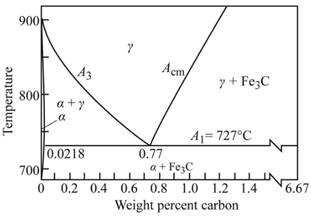
Calculations:
As shown in the given diagram, at the line
As from the figure, the effect of hardness of martensite in steel, the hardness of martensite at
Where, %M=amount of martensite
Put, the values in lever rule,
Therefore,
(c)
Interpretation:
The amount composition & hardness of material at
Concept Introduction:
Material hardness is the property of a metal due to which material resist the plastic deformation.Plastic deformation means material deformation which undergoes non-reversible change. Hardness is the property of any material which process stiffness resistance to bending, scratching or cutting. Hardness is not constant or fixed for all material, but it depends upon strength and plasticity of metal. Material hardness is expressed in terms of hardness number.
Answer to Problem 12.103P
The composition, hardness and amount are
Explanation of Solution
Given:
Graph showing
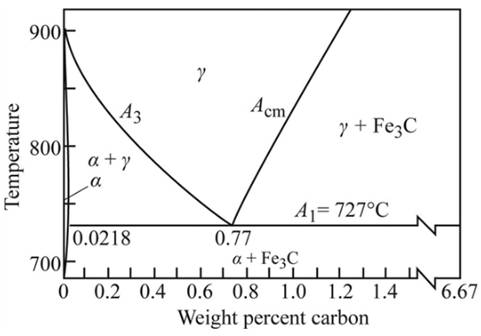
Calculations:
As shown in the given diagram, at the line
As from the figure, the effect of hardness of martensite in steel, the hardness of martensite at
Where, %M=amount of martensite
Put, the values in lever rule,
Therefore,
(d)
Interpretation:
The amount composition & hardness of material at
Concept Introduction:
Material hardness is the property of a metal due to which material resist the plastic deformation. Plastic deformation means material deformation which undergoes non-reversible change. Hardness is the property of any material which process stiffness resistance to bending, scratching or cutting. Hardness is not constant or fixed for all material, but it depends upon strength and plasticity of metal. Material hardness is expressed in terms of hardness number.
Answer to Problem 12.103P
The composition, hardness and amount are
Explanation of Solution
Given:
Graph showing
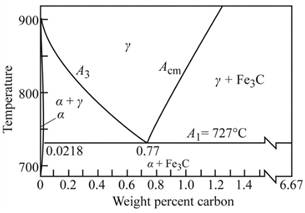
Calculations:
As shown in the given diagram, at the line
As from the figure, the effect of hardness of martensite in steel, the hardness of martensite at
Where, %M=amount of martensite
Put, the values in lever rule,
Therefore,
Want to see more full solutions like this?
Chapter 12 Solutions
Essentials Of Materials Science And Engineering
- jan G(f) f Sketch the spectrum of g(t), which has a maximum frequency of 5 kHz, if it is sampled at the following sampling frequencies: 7 kHz, 10 kHz and 15 kHz. Indicate if and how the signal can be recovered at each sampling frequency.arrow_forwardDon't use ai to answer i will report your answerarrow_forwardA single tone is modulated using FM transmitter. The SNR, at the input of the demodulator 20 dB. If the maximum frequency of the modulating signal is 4 kHz, and the maximum equency deviation is 12 kHz, find the SNR, and the bandwidth (using Carson rule) at the ollowing conditions: . For the given values of fm and Af. !. If the amplitude of the modulating signal is increased by 80%. 3. If the amplitude of the modulating signal is decreased by 50%, and frequency of modulating signal is increased by 50%.arrow_forward
- The circuit shown below on the left has the following parameters: V₁ = 5 V. R₁ = 40, R₂ = 40, α = 0.1. This circuit can be replaced by an equivalent circuit shown below on the right such that the voltage and current received by an arbitrary load resistor RL, are identical when connected to either circuits. Determine the value of the resistor R (in ) in the equivalent circuit. R₁ Rx R2 R₁ Vx R₁ Vi απ. barrow_forwardLab 07: Java Graphics (Bonus lab) In this lab, we'll be practicing what we learned about GUIs, and Mouse events. You will need to implement the following: ➤ A GUI with a drawing panel. We can click in this panel, and you will capture those clicks as a Point (see java.awt.Point) in a PointCollection class (you need to build this). о The points need to be represented by circles. Below the drawing panel, you will need 5 buttons: о An input button to register your mouse to the drawing panel. ○ о о A show button to paint the points in your collection on the drawing panel. A button to shift all the points to the left by 50 pixels. The x position of the points is not allowed to go below zero. Another button to shift all the points to the right 50 pixels. The x position of the points cannot go further than the You can implement this GUI in any way you choose. I suggest using the BorderLayout for a panel containing the buttons, and a GridLayout to hold the drawing panel and button panels.…arrow_forwardK/S 46. (O المهمات الجديدة 0 المنتهية 12 المغـ ۱۱:۰۹ search ليس لديك اي مهمات ☐ ○ ☑arrow_forward
- the answer should be: V2= -(P0-PL/2μL)(dx-x^)+Ux/darrow_forwardFor some viscoelastic polymers that are subjected to stress relaxation tests, the stress decays with time according to a(t) = a(0) exp(-4) (15.10) where σ(t) and o(0) represent the time-dependent and initial (i.e., time = 0) stresses, respectively, and t and T denote elapsed time and the relaxation time, respectively; T is a time-independent constant characteristic of the material. A specimen of a viscoelastic polymer whose stress relaxation obeys Equation 15.10 was suddenly pulled in tension to a measured strain of 0.5; the stress necessary to maintain this constant strain was measured as a function of time. Determine E (10) for this material if the initial stress level was 3.5 MPa (500 psi), which dropped to 0.5 MPa (70 psi) after 30 s.arrow_forward1. Consider the following a unity feedback control system. R(s) + E(s) 500(s+2)(s+5)(s+6) s(s+8)(s+10)(s+12) -Y(s) Find the followings: a) Type of the system b) Static position error constant Kp, Static velocity error constant Ry and Static acceleration error constant Ka c) Find the steady-state error of the system for (i) step input 1(t), (ii) ramp input t 1(t), (iii) parabolic input t² 1(t). 2. Repeat the above problem for the following system. R(s) + E(s) 500(s + 2)(s + 5) (s+8)(s+ 10)(s+12) Y(s) 3. Repeat the above problem for the following system. R(s) + E(s) 500(s+2)(s+4)(s+5)(s+6)(s+7) s²(s+8)(s+10)(s+12) Y(s)arrow_forward
- For the flows in Examples 11.1 and 11.2, calculate the magnitudes of the Δ V2 / 2 terms omitted in B.E., and compare these with the magnitude of the ℱ terms.arrow_forward4. Consider a unity (negative) feedback control system whose open-loop transfer function is given by the following. 2 G(s) = s³ (s + 2) Find the steady-state error of the system for each of the following inputs. = a) u(t) (t²+8t+5) 1(t) b) u(t) = 3t³ 1(t) c) u(t) (t+5t² - 1) 1(t) =arrow_forward1 2. For the following closed-loop system, G(s) = and H(s) = ½ (s+4)(s+6) a. Please draw the root locus by hand and mark the root locus with arrows. Calculate the origin and angle for asymptotes. b. Use Matlab to draw the root locus to verify your sketch. Input R(s) Output C(s) KG(s) H(s)arrow_forward
 MATLAB: An Introduction with ApplicationsEngineeringISBN:9781119256830Author:Amos GilatPublisher:John Wiley & Sons Inc
MATLAB: An Introduction with ApplicationsEngineeringISBN:9781119256830Author:Amos GilatPublisher:John Wiley & Sons Inc Essentials Of Materials Science And EngineeringEngineeringISBN:9781337385497Author:WRIGHT, Wendelin J.Publisher:Cengage,
Essentials Of Materials Science And EngineeringEngineeringISBN:9781337385497Author:WRIGHT, Wendelin J.Publisher:Cengage, Industrial Motor ControlEngineeringISBN:9781133691808Author:Stephen HermanPublisher:Cengage Learning
Industrial Motor ControlEngineeringISBN:9781133691808Author:Stephen HermanPublisher:Cengage Learning Basics Of Engineering EconomyEngineeringISBN:9780073376356Author:Leland Blank, Anthony TarquinPublisher:MCGRAW-HILL HIGHER EDUCATION
Basics Of Engineering EconomyEngineeringISBN:9780073376356Author:Leland Blank, Anthony TarquinPublisher:MCGRAW-HILL HIGHER EDUCATION Structural Steel Design (6th Edition)EngineeringISBN:9780134589657Author:Jack C. McCormac, Stephen F. CsernakPublisher:PEARSON
Structural Steel Design (6th Edition)EngineeringISBN:9780134589657Author:Jack C. McCormac, Stephen F. CsernakPublisher:PEARSON Fundamentals of Materials Science and Engineering...EngineeringISBN:9781119175483Author:William D. Callister Jr., David G. RethwischPublisher:WILEY
Fundamentals of Materials Science and Engineering...EngineeringISBN:9781119175483Author:William D. Callister Jr., David G. RethwischPublisher:WILEY





